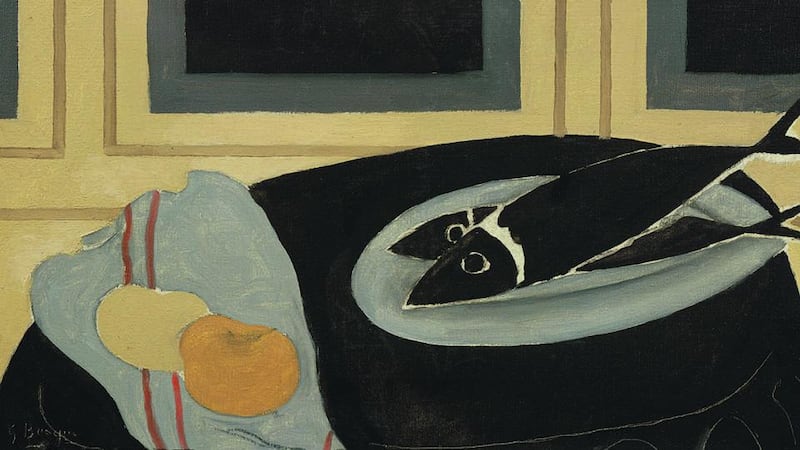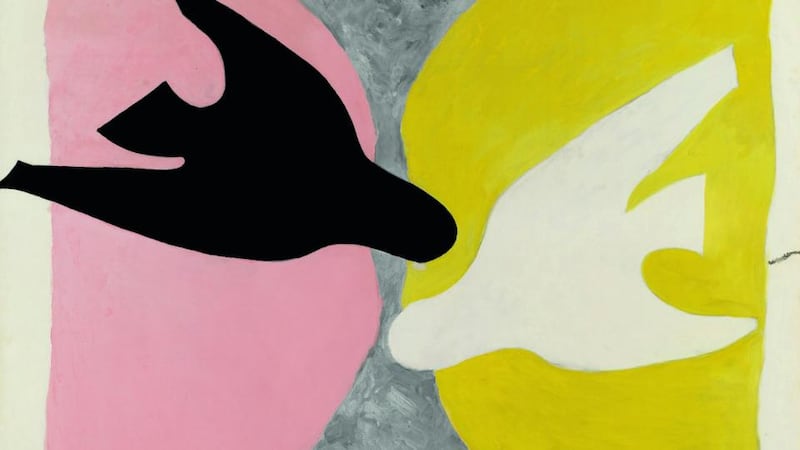'Was Picasso the misfortune of Braque?" asks Brigitte Leal, the commissioner of the splendid Georges Braque retrospective at the Grand Palais. Picasso's advocates were so fervent, his fame so overpowering, that Braque appeared doomed to play second fiddle.
Fifty years after Braque's death, and 40 years after the last Braque retrospective at the Orangerie, the Grand Palais has brought together 238 of his paintings, engravings, sculptures and drawings. Unlike Picasso and Braque: Pioneering Cubism at MoMa in New York in 1989, this exhibition considers Braque's oeuvre on its own merits.
The two artists were born seven months apart in 1881 and 1882. Both moved to Montmartre in 1904. In 1907 the writer and art critic Guillaume Apollinaire took Braque to Picasso's Bateau-Lavoir studio. Braque was so jolted by the Demoiselles d'Avignon, which he compared to a man spitting petrol flames, that he painted his own massive, muscular Grand Nu in response.


For seven years they were inseparable. “Despite our very different temperaments,” Braque recalled, “we were guided by the same idea. We saw each other every day. During those years Picasso and I said things to each other than no one will ever say again.Things that would be incomprehensible, and which gave us such joy. We were like mountaineers roped together.”
In revolt against the Impressionists, who had abandoned form for the sake of light and colour, and the fauves, who amplified colour to unprecedented intensity, Braque and Picasso reduced their palettes to shades of grey and beige to give all to form, breaking it down into countless facets. Their canvases were so similar that they were sometimes unsure who had painted what. Thus cubism was born.
Cubist landscapes
It was Braque who painted the first Cézanne-like cubist landscapes in 1908, after he had been "seized" by a Cézanne retrospective. In the first "analytic" phase of cubism, Braque and Picasso teetered on the brink of abstraction. It was Braque who pulled back by introducing stencilled letters and numerals as a link with reality. In 1912 Braque invented the papier collé (a type of collage), including three scraps of wallpaper in Compotier et verre.
When the first World War started, Braque volunteered. “I took Braque to the train station and I never saw him again,” Picasso said metaphorically. In 1915 Braque received a shrapnel wound to the head. He lost consciousness for two days, was temporarily blind when he woke up, was trepanned, and could not paint again until 1917. He felt he had been overtaken by those who, like Picasso, continued to create during the war.
Until Braque’s death in 1963, he and Picasso remained frenemies, meeting occasionally for meals, observing each other’s work with suspicion. Visiting an exhibition of Braque’s painting, Picasso remarked that it was “well hung”. Braque returned the damning faint praise, saying that Picasso’s ceramics were “well fired”.
Braque was the anti-Picasso, seemingly void of the unbridled sexuality that permeates the Spaniard's work. Picasso was fiery; Braque self-contained. "I love the rule that corrects emotion," he wrote in 1917. Picasso was fast; Braque slow. Between 1912 and 1914, Picasso created 300 papiers collés; Braque 57. Braque often took years to complete a painting.
The French academician Michel Déon has written of Braque’s “radiant goodness” and “supreme honesty”. Braque, steeped in oriental philosophy, believed less was more. “You take something out and everything becomes more beautiful, more true,” he said. “You add something and it’s ruined.” Like Chardin in the 18th century, Braque was a painter of silence.
Braque emerged from his long convalescence with La Musicienne (1917-1918), whose quiet majesty evokes comparisons with Renaissance madonnas. A face is barely suggested, with a pair of eyes behind a burka-like mask. Two hands, one holding what appears to be the handle of a sword, and what may be a foot, are the spare suggestions of a woman's figure. La Musicienne mixes wallpaper, wood and tapestry motifs, and introduces colour to "synthetic" – more legible – cubism.
After the first World War Braque renounced avant-gardism to recentre his oeuvre on still lifes and landscapes, the staples of classic French painting. He painted fruit bowls, and devoted himself to the silent poetry of quotidian objects.
When the Nazis occupied France, Braque withdrew to his home at Varengevill, on the coast of Normandy. He painted skulls, crucifixes, rosary beads and fish: symbols of Christ. Muted anxiety suffuses his canvases, which are dominated by black, such as in Les Poissons noirs (1942).
Braque said he went deep into himself in his Ateliers series (1949-1956). "In painting them, a sort of jubilation took hold of me. I was in the happy state of someone to whom the harmony of things is revealed."
The bird, Braque said, “summarises all my art”. In his paintings inanimate objects sprout swans’ necks and wings, take flight.
À tire d'aile (Swiftly), painted between 1956 and 1961, has been interpreted as a premonition. Four decades before September 11th, 2001, a black bird resembling an airliner flies into a black tower, against a pale blue sky. On the margin of a study for the painting, Braque wrote: "Without respite, we chase after our destiny."
In his last years Braque came full circle, returning to the theme, though not the style, of the open-air landscapes he painted during his 1906-1907 fauvist period. These long, horizontal panoramas of fields, sea and sky, occasionally inhabited by birds, are his homage to van Gogh.
Over the decades France's intellectual elite came to favour Braque over Picasso. The writer and director of the prestigious Nouvelle Revue Française, Jean Paulhan, said: "Picasso makes so much noise that one loves Braque at first for his discretion, then for his silence, and . . . one thinks he knows much more than the other."
Unlike Picasso, Braque looked the part of a distinguished painter. In 1958, the photographer Henri Cartier-Bresson described “his handsome face, like supple leather with its rich patina the colour of fine tobacco . . . That handsome, serious face radiating silent suffering.”
Funeral and rehabilitation
When Braque died in 1963, the culture minister André Malraux organised a state funeral. In his oration, Malraux compared Braque to Victor Hugo. The extravagant farewell seemed to mark the passing of Paris as the world's artistic capital.
The Gaullist establishment did Braque a disservice by embracing him so tightly, says Brigitte Leal. The May 1968 generation saw him as a representative of their parents’ order.
Now is the time for rehabilitation, Leal says. The generation that missed out on Braque must be allowed “to discover in its amplitude and richness an oeuvre that is underestimated, because it is demanding, because it resists facile telling, and is profoundly modest”.
Until January 6, 2014, grandpalais.fr, then the Museum of Fine Arts in Houston from February 16 until May 11
Life line: Georges Braque
1882 Braque is born in Argenteuil outside Paris. His father and grandfather were house painters.
1905-1907 Joins the fauve movement on the Côte d'Azur.
1907 Guillaume Apollinaire introduces him to Picasso. The painters are inseparable for seven years. They co-invent cubism, destroying the rules of perspective that had dominated western art since the Renaissance.
1908 Braque paints the first cubist landscapes, in the style of Cézanne.
1912 He creates the first papier collé, when he glues wood-grained wallpaper on to Compotier et verre.
1914 Volunteers to fight in the first World War. He is gravely wounded in 1915 and cannot paint for two years.
1917-1918 Resumes painting with La Musicienne, which brings colour to cubism.
1941-1944 Spends the German occupation on the Normandy coast, painting sombre pictures of skulls and black fish.
1944-1963 Paints billiard tables, artists' ateliers, birds and landscapes.
1963 Given a state funeral.












